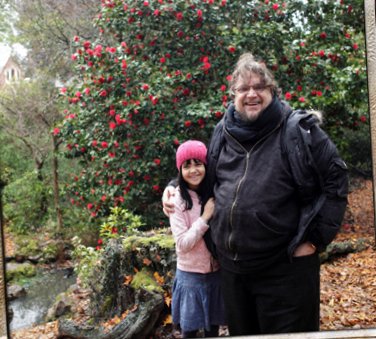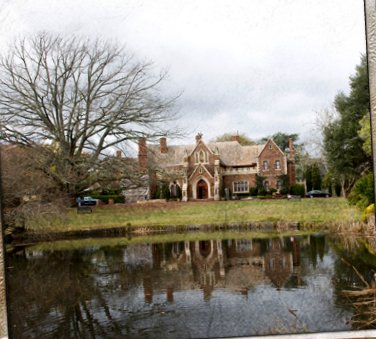Guillermo Del Toro: The Interview, Part I
[This posting originally appeared on wired.com's Geek Dad]
 Guillermo del Toro and star Bailee Madison, on the set of "Don't Be Afraid of the Dark" (Courtesy of FilmDistrict Distribution)Guillermo Del Toro, the director behind personal, vision-driven films like Cronos, The Devil’s Backbone, and Pan’s Labyrinth, plus commercial blockbuster action vehicles like Blade II and two Hellboy films, has been involved in more than his share of film projects over the past few years. But he hasn’t personally helmed a picture since 2008’s Hellboy II: The Golden Army. So fans of del Toro the film director – not the screenwriter, producer, executive producer, video game designer, novelist, and creative consultant – will have to keep waiting.
Guillermo del Toro and star Bailee Madison, on the set of "Don't Be Afraid of the Dark" (Courtesy of FilmDistrict Distribution)Guillermo Del Toro, the director behind personal, vision-driven films like Cronos, The Devil’s Backbone, and Pan’s Labyrinth, plus commercial blockbuster action vehicles like Blade II and two Hellboy films, has been involved in more than his share of film projects over the past few years. But he hasn’t personally helmed a picture since 2008’s Hellboy II: The Golden Army. So fans of del Toro the film director – not the screenwriter, producer, executive producer, video game designer, novelist, and creative consultant – will have to keep waiting.
Perhaps he has simply been the victim of bad luck.
Originally recruited to co-write and direct The Hobbit, del Toro even relocated his family to New Zealand. But after interminable production delays, he backed out, and now Peter Jackson is directing. Del Toro’s next project was to be an effects-laden, 3D adaptation of H.P. Lovecraft’s novella At the Mountains of Madness. Yet studios balked at the $150-million price tag (even with Tom Cruise attached). It turns out del Toro’s next directorial effort will be a Japanese-style monsters versus robots film called Pacific Rim, with a slated release date of 2013.
In the meantime, fans will have to sate themselves with a new project heavy with the del Toro imprint but not officially part of his directorial oeuvre: Don’t Be Afraid of the Dark, a throwback to old-timey haunted house films. Though he only co-wrote and produced the film — the director is newcomer Troy Nixey — Don’t Be Afraid (opening Friday) contains many familiar del Toro themes: a flashback prologue; mysterious and maleficent creatures, and a hidden world of fantasy revealed by a child protagonist.
The original Don’t Be Afraid of the Dark was a 1973 ABC made-for-TV movie about a young couple in an abusive relationship who inherit an old mansion. Del Toro has claimed that, for his generation (he was 9 at the time), this was “the scariest TV movie we ever saw.” Del Toro began co-writing his version with Matthew Robbins in 1998, but the production had its own delays. Switching the focus to the couple’s daughter, he realized the plot was too similar to Pan’s Labyrinth, so he put the project on hold. He kept pursuing it over the past dozen years, finally beginning production two years ago when he felt the time was right.
Shot in Australia, Don’t Be Afraid of the Dark is set in present day Rhode Island. An architect (Guy Pearce) and his interior-designer girlfriend (Katie Holmes) renovate and move into a lavish mansion. The architect’s introverted daughter, Sally (Bailee Madison from Bridge to Terabithia), reluctantly joins them. The de rigueur prologue concerns the previous owner of Blackwood Manor, a Victorian-era, Audubon-like illustrator and naturalist who became enslaved to an ancient evil inhabiting the basement’s ash pit.
I had a chance to speak with Guillermo del Toro, via telephone from New York City. We had met in person last year, when del Toro was in Boston promoting The Fall, the second book in his horror novel trilogy The Strain, co-authored with Massachusetts resident Chuck Hogan. (The final volume The Night Eternal comes out October 25.)
Ethan Gilsdorf: Hello, Mr. del Toro. It’s a pleasure to speak with you again. We met about a year ago in Boston when you were promoting The Fall. I was the guy who wrote that book Fantasy Freaks and Gaming Geeks. We traded books, I seem to recall.
Guillermo del Toro: I remember that, yes. You went to New Zealand for Lord of the Rings.
EG: I’m glad you remembered! Yes, I was that crazy nut who traveled there to see as many of the Lord of the Rings filming locations as I could in three weeks.
GDT: [Laughs]
EG: Yeah, it’s all in my book. So, I should probably get right to the questions since I know you have a limited amount of time. I saw Don’t Be Afraid of the Dark last night and I very much enjoyed it. Can you talk your decision in this case to co-write and producer rather than direct this film yourself?
 Blackwood Manor, home to nasty and evil forces. (Courtesy of FilmDistrict Distribution)GDT: I co-wrote the movie with Matthew Robbins in 1998. And in the interim, I did Pan’s Labyrinth. I thought anecdotally and superficially the two movies shared certain traits. A young girl arriving at a foreign place, to an old mansion, discovering creatures underground. I thought about it and I thought, although it was very different, I thought it was superficially, professionally, too much in common. I didn’t want to repeat. I thought, however, I would be very, very involved in the making of the movie.
Blackwood Manor, home to nasty and evil forces. (Courtesy of FilmDistrict Distribution)GDT: I co-wrote the movie with Matthew Robbins in 1998. And in the interim, I did Pan’s Labyrinth. I thought anecdotally and superficially the two movies shared certain traits. A young girl arriving at a foreign place, to an old mansion, discovering creatures underground. I thought about it and I thought, although it was very different, I thought it was superficially, professionally, too much in common. I didn’t want to repeat. I thought, however, I would be very, very involved in the making of the movie.
EG: Troy Nixey, the director you chose, comes from comic books. He illustrated for the Batman franchise and Neil Gaiman’s Only the End of the World Again, among other things. But Nixey had made just one short film, Latchkey’s Lament. Why did you pick him?
GDT: Yes, [Nixey was] a first time feature filmmaker. He had done a wonderful short called Latchkey’s Lament, and I saw that short. It’s really, really quite beautiful. It’s available to see on YouTube. You can just type “Latchkey’s Lament” and you can see why he got the job. [See the film here]
EG: For someone like Nixey, who has gone from a short film to a pretty major production, with some major actors and obviously a lot of special effects work and so on, I wonder if that required any special attention on your part? Were you there on the set quite often to oversee things, or did he get to run with things on his own?
GDT: Yes, this is the movie I have produced where I have been the most involved in every facet of it. It’s the only movie I have produced where I have been, almost 90 percent of the time on the set, every day, because it was a big job to go from a short film as I say to something that intricate and that complicated. Also, we did it for a budget and a very tight schedule. Ultimately, we delivered the movie under budget and under schedule. Which was great, but to do so was a very complicated process.
 This is a haunted house movie. Better bring your flashlight. (Courtesy of FilmDistrict Distribution)EG: There have been so many movies made over the years that try to scare people or try to disturb them, or try to effect them emotionally. I was wondering when you are selecting your projects, whether you are directing or want to direct, or just to be attached to, how do you think outside of the box? Particularly with horror movies, it does seem like they are a dime a dozen at this point. How do you be original?
This is a haunted house movie. Better bring your flashlight. (Courtesy of FilmDistrict Distribution)EG: There have been so many movies made over the years that try to scare people or try to disturb them, or try to effect them emotionally. I was wondering when you are selecting your projects, whether you are directing or want to direct, or just to be attached to, how do you think outside of the box? Particularly with horror movies, it does seem like they are a dime a dozen at this point. How do you be original?
GDT: I think that the case of the genre of horror movies, they are a way to make a quick buck. There are very few filmmakers both on the producing and directing side who actually approach [horror] with the desire to create something either of substance or something beautiful or powerful. Most of the people just try to get a [big opening] weekend and DVD sales.
The first thing is, I don’t get attached, or I rarely get attached, to something I’m not generating from the get go. Don’t Be Afraid is no exception. I started working on this project actively about 16 years ago now. We wrote it in 1998 which was about 13 years ago. And I have not stopped pursuing it actively. So I really just try to get involved in things I feel truly passionate about, and if I happen to be able to control the rights or hold the rights, I don’t let them go. I just hold onto the project until it gets made. If I don’t control the rights, that’s a different matter.
EG: You grew up in one culture, Mexico, and largely work in another, by which I mean the American film system. Obviously your audiences are world-wide, but a good chunk of them are American. Do you find there is a universal thread that connects audience sfrom one culture to another, in terms of what disturbs them or what haunts them? Are there specific kinds of themes that always work?
GDT: I think that no matter what culture you come from [you] are afraid of the darkness, and what lurks in it is an absolutely common fear. I think that Don’t Be Afraid of the Dark is tapping into the most primal, almost universal, childhood fears. That’s what attracted me from the get-go to the idea of making this remake, a complete re-telling of this story. The movie from 1973 was about a very specific, abusive relationship between a husband and wife, and it was very much a product of its time. … I decided to turn it into a sort of a very dark fairy tale. Precisely, as I say, that taps into universal fears — the invasion of the more intimate spaces, the home, the bedroom, the bed — and little by little we show that these creatures can be anywhere at any time, watching from the dark.
And that’s the end of Part I. Tune in tomorrow for Part II, when the conversation with Guillermo del Toro continues. Among other topics, we discuss why the horror genre is underappreciated, how he sees his own evolution as a filmmaker, his relationship with Peter Jackson, his new video game project, and — of course — what scares him.
[Note: Portions of this interview originally appeared in a different form in an article for the Boston Sunday Globe]